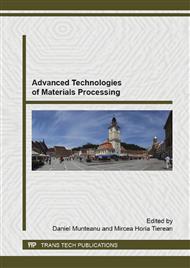p.261
p.271
p.282
p.288
p.293
p.303
p.315
p.322
p.332
Optimization of Abrasive Water Jet Cutting for Carburized Pieces
Abstract:
Parametric optimization model was made by now for abrasive water jet process, only for materials with uniform hardness. Pieces, subject to deep carburized treatment with high hardness in layer and softened in core, have a different behaviour and it is necessary to estimate new values of the system processing. Experiments consisted in cutting with abrasive water jet of rectangular samples with 10 mm thickness and deep carburized layers with 8 mm thickness, obtained as a result of deep carburized heat treatment. Abrasive water jet, initially meets the carburized layer with 62 HRC, after perforation followed the layer with fine sorbite structure (30 HRC). The different hardness causes a change in the trajectory of abrasive particles, determining deformations and micro cracks in materials to the limits of carburized layers. Choosing an optimal cutting regim becomes important not only economically, as well as qualitative. Measurements allow drawing conclusions that can be generalized to the materials with different hardness.
Info:
Periodical:
Pages:
293-302
Citation:
Online since:
October 2015
Keywords:
Price:
Сopyright:
© 2015 Trans Tech Publications Ltd. All Rights Reserved
Share:
Citation:


